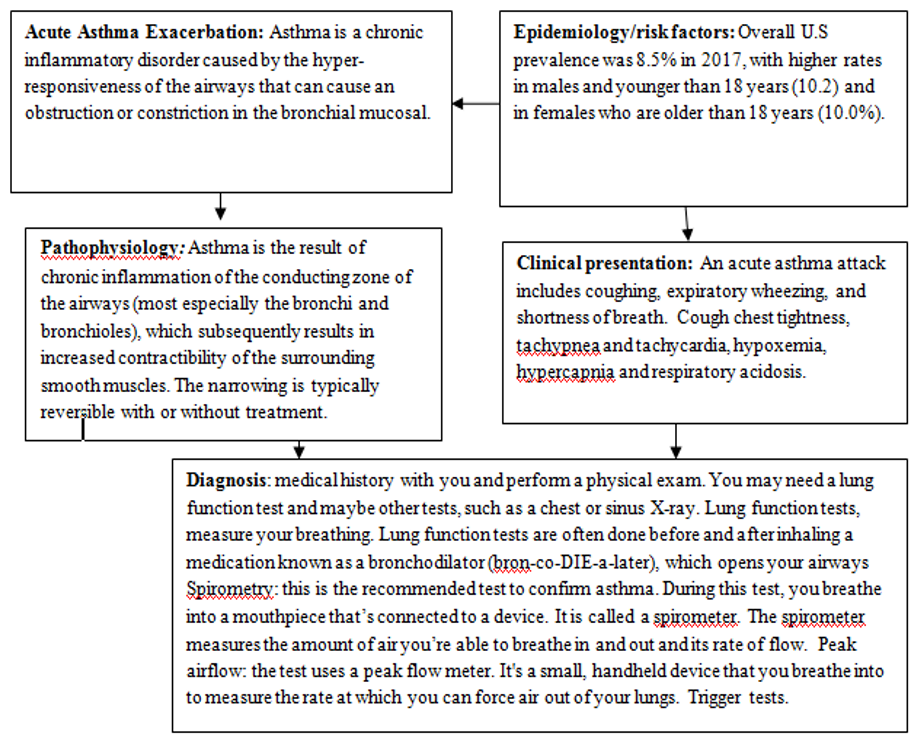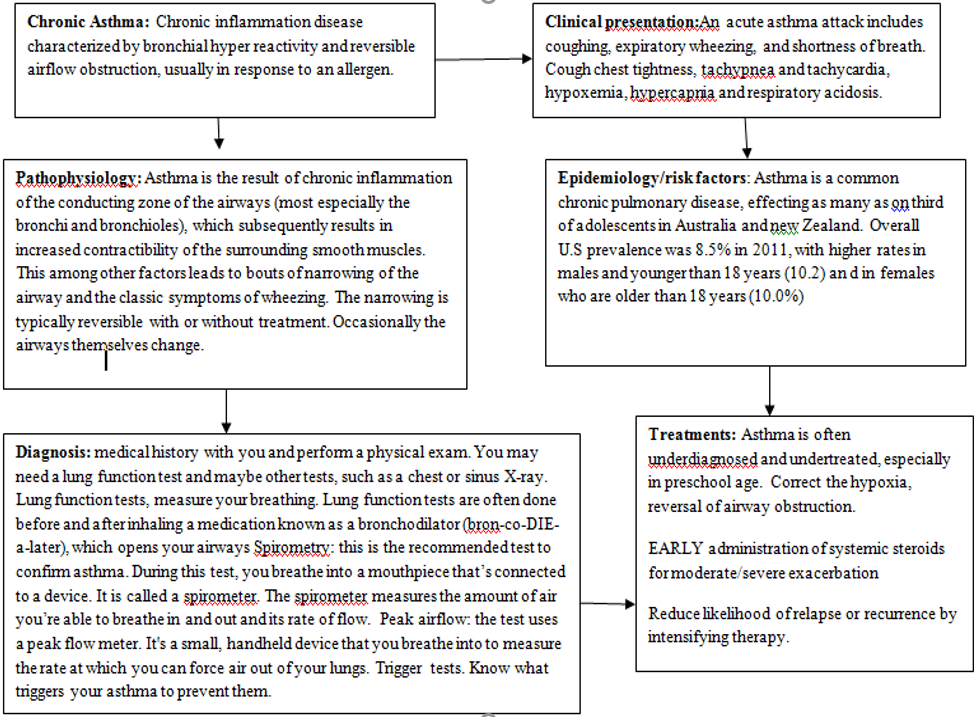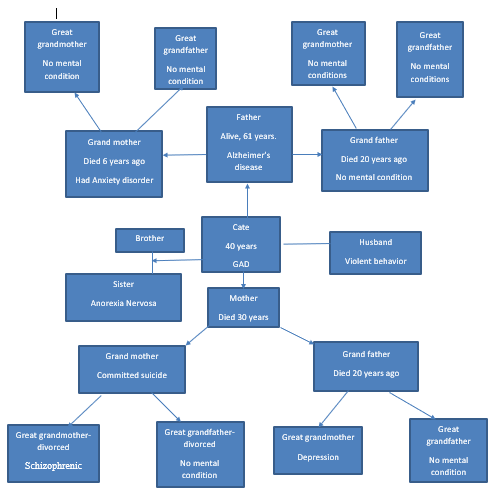Chronic and Acute Asthma
Chronic and Acute Asthma
Write a 2- to 3-page paper that addresses the following:
1. Describe the pathophysiological mechanisms of chronic asthma and acute asthma exacerbation. Be sure to explain the changes in the arterial blood gas patterns during an exacerbation.
2. Explain how the factor you selected might impact the pathophysiology of both disorders. Describe how you would diagnose and prescribe treatment for a patient based on the factor you selected.
3. Construct two mind maps—one for chronic asthma and one for acute asthma exacerbation. Include the epidemiology, pathophysiology, and clinical presentation, as well as the diagnosis and treatment you explained in your paper.
Note: The School of Nursing requires that all papers submitted include a title page, introduction, summary, and references.
SAMPLE ANSWER
Asthma
Asthma is referred to as a chronic inflammatory disorder that causes constriction and obstruction of the bronchial mucosal. Asthma attack can also lead to inflammation of the smooth muscles due to the hyper- responsiveness of the airway resistance or narrowed (Wenzel et al. 2016). Both acute and chronic asthma are often similar in their pathophysiology. This paper analyzes the pathophysiological mechanisms of chronic asthma and acute asthma and explains the changes in the arterial blood gas patterns during an exacerbation (Wenzel et al. 2016). The paper also explains how age factor impact the pathophysiology of both disorders.
Chronic Asthma Exacerbation
The pathophysiology of chronic asthma is characterized by bronchoconstriction stimuli and mucus secretion. The bronchoconstriction is caused by peptide neurotransmitters, the bronchial neural function, and induced by smooth muscle contractions (Evans et al. 2012). In the early stages, the toxic neuropeptides, and eosinophils are released leading to the inflammatory response and bronchial hyper-responsiveness (Evans et al. 2012). Oxygenation is also involved in chronic asthma because of the bronchial airway restriction. Hyperventilation often affects the arterial blood gas leading to hypoxemia and respiratory alkalosis in patents.
ORDER A PLAGIARISM FREE PAPER HERE
Acute Asthma Exacerbation
The pathophysiologymechanism of acute asthma results when bronchial airways are affected leading to resistance in the airway. Many cells often lead to hypersensitivity of the airway in acute Asthma such as basophils, eosinophil, neutrophils, mast cells, B lymphocytes, T helper 2 lymphocytes, and dendritic (Lemanske & Busse, 2010). These cells react differently causing inflammatory that may lead to increase in secretions, edema, and bronchospasm. The arterial blood gas in chronic asthma also results due to short inspirations and long expirations due to lack of oxygenation. Patients often trap air due to short and long inspirations that cause respiratory acidosis due to respiratory disadvantage increase in carbon dioxide and a decrease intidal volume (Lemanske & Busse, 2010).
Impact of Age Factor
Asthma as a chronic pulmonary infection affects both adults and children. However, researchers have shown that it is more affected by children below the age of 17 years old (Hasegawa et al. 2015). Therefore, asthma affects people of all ages, from infants to older adults. Although treatment may be challenging due to detailed assessment, the inability to distinguish the signs and symptoms of asthma and manage treatments may occur (Ponikowski et al. 216). When assessing patients with respiratory issues, nurses and physicians must conduct analysis of the vaccination, history and physical records to help understand the patient condition and present re-infection of other diseases.
Asthma may be acute or chronic in both children and adults leading to inflammation and increase level of mucus affecting the flow of air. Exacerbation is caused by inflammation and sensitivity. However, it is sometimes due to asymptotic attacks (Ponikowski et al. 216). During exacerbation, patients may experience the use of accessory muscles, increased heart rate, prolonged expiration, expiratory wheezing, nonproductive cough, dyspnea, inability to breathe, and tightness of the chest (Ponikowski et al. 216). Thus, many factors can lead to exacerbation, in all ages including not get enough inhalers, not using medication properly, second-hand smoking in children, allergy season, and flowering season.
Mind Maps
Acute Asthma

Chronic Asthma

Summary
Asthma clinical presentation may be challenging to understand but identifying its signs and symptoms early is important to prevent acute or chronic asthma. Asthma is primarily linked with recurrent of episodes of dyspnea and wheezing, hyper-responsiveness of the airway to stimuli and physical of allergies. Asthma can be prevented through compliant with medications and treatments since its pathophysiology is similar in adults and children. If it remains untreated, it can lead to death making prevention of recurrence asthma critical.
References
Wenzel, S. E., Jayawardena, S., Graham, N. M., Pirozzi, G., & Teper, A. (2016). Severe asthma
and asthma-chronic obstructive pulmonary disease syndrome–Authors’ reply. The Lancet, 388(10061), 2742. DOI:https://doi.org/10.1016/S0140-6736(16)31720-2
Ponikowski, P., Voors, A. A., Anker, S. D., Bueno, H., Cleland, J. G., Coats, A. J., … & Jessup,
- (2016). 2016 ESC Guidelines for the diagnosis and treatment of acute and chronic heart failure: The Task Force for the diagnosis and treatment of acute and chronic heart failure of the European Society of Cardiology (ESC). Developed with the special contribution of the Heart Failure Association (HFA) of the ESC. European journal of heart failure, 18(8), 891-975.
https://doi.org/10.1002/ejhf.592
Hasegawa, K., Cydulka, R. K., Sullivan, A. F., Langdorf, M. I., Nonas, S. A., Nowak, R. M., …
& Camargo Jr, C. A. (2015). Improved management of acute asthma among pregnant women presenting to the ED. Chest, 147(2), 406-414. https://search.proquest.com/openview/dced603cde8234803185d32130a4b1ba/1?pq-origsite=gscholar&cbl=40575
Evans, R. L., Nials, A. T., Knowles, R. G., Kidd, E. J., Ford, W. R., & Broadley, K. J. (2012). A
comparison of antiasthma drugs between acute and chronic ovalbumin-challenged guinea-pig models of asthma. Pulmonary pharmacology & therapeutics, 25(6), 453-464. DOI: 10.1183/09031936.00057710
Lemanske Jr, R. F., & Busse, W. W. (2010). Asthma: clinical expression and molecular
mechanisms. Journal of Allergy and Clinical Immunology, 125(2), S95-S102. https://www.sciencedirect.com/science/article/pii/S0091674909016133
Needs help with similar assignment?
We are available 24x7 to deliver the best services and assignment ready within 3-4 hours? Order a custom-written, plagiarism-free paper


